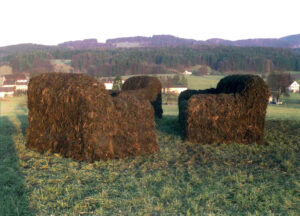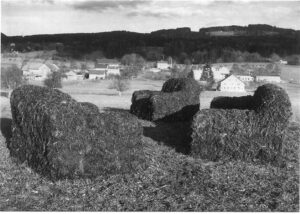“sofa group made out of cow dung ” Erlosen, municipality of Hinwil in the Zurich Oberland 1989
In the 1980s, I started to suspect that nature, on land, on water and in the air, the forestry and agricultural land and the roads were a free sporting facility for all children and everyone who earned their living in offices or in the public service.
My attitude to the old fairy tale of condensed building on the outskirts of the city would prevent urban sprawl, the core theme of “Comfort in the recreation area”, has not changed over the years. Artistically, in “Comfort in the recreation area” I moved away from the urban development concept with its vocabulary of words such as “recreational space”, “public space” or “settlement space” and from the fairy tale that urban development works for the benefit of the population. Together with photographer and theater artist Etienne de Graffenried and stage technician Hans Mader, the three of us built the sofa group on a scale of 2:1 out of cow dung, that I borrowed from the farmer .
Etienne de Graffenried carefully documented the project photographically and participated in the six-day construction of the oversized seating area in wind, rain and snow.
Comet photo agency, specialist for aerial photography sent over a photographer with a high ladder. The Sonntagszeitung from Zurich was given the exclusive right to publish Comet’s photo with text for December 24, 1989.
The daily press picked up the article, which appeared in over 20 other newspapers the following week with Comet’s picture and text.
The installation remained in place for 12 weeks until the farmer cleared it away. In the meantime, the work had been given the name Dung Sofa.
My reasoning behind the idea of building a sofa group out of cow dung was the idea that no amount of high condensed construction on the outskirts of the city does fulfill the promise of counteracting urban sprawl. For the land that today is “recreational space” for city dwellers will tomorrow be the precious building ground of anonymous “settlement areas” or “industrial estates”.
Today I know that urban sprawl over agricultural land is an economic mechanism that generates added value locally without labor. No reasonable approach can put a stop to the urban sprawl. There are other ways to extract value without labor, but the growth of cities, from which wealth is created without local labor due to property rights, is one of the most powerful motors of economic growth.
The hill between Wetzikon and Hinwil, where the sofa group stood, is still agricultural land in 2024.
I have a whole stack of black and white postcards with Comet’s agency picture of the sofa group together with the three people who were building the dung heaps. I also have numerous large-format black and white copies of the photographs from the photo documentation made by Etienne de Graffenried.


